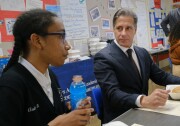LAUSD Assigns Millions In Funding For 'Green Schoolyards'

A years-long pandemic. A youth mental health crisis. School shootings. Kids and schools have a lot to deal with these days. Worsening extreme heat is yet another challenge to add to the list.
Last week, the board of the L.A. Unified School District (LAUSD) approved a $13 billion-dollar operating budget that includes funding to help.
Some $58 million of those funds are slated to go towards outdoor education initiatives, as well as adding more green space to L.A.’s famously asphalt-heavy schoolyards — something advocates say is a long time coming.
“When we think about the places that we have created for students, which are schoolyards that are completely covered in asphalt…that's not conducive to creating an environment that is healthy for kids to learn and thrive,” said Robin Mark, the L.A. director for the nonprofit Trust for Public Land, which for years has worked with a coalition of community organizations to get more green space at L.A. schools.
She said more trees and greenery at schools is essential for building resilience in the face of the climate crisis: Southern California is increasingly experiencing more extreme heat. For example, Santa Clarita is projected to have 124 days above 90°F by as soon as 2035 if emissions aren’t curbed significantly to slow global heating this decade.
-
At magnitude 7.2, buildings collapsed
-
Now spinning in front of Santa Monica apartments
-
Advocates seek end to new LAUSD location policy
“The big elephant in the room is climate change, and we know that we're getting hotter,” said Mark, whose kids attend Eagle Rock Elementary. “My kids have had to stay inside the classroom or inside the gym on really hot days because it's not healthy for them to be outside. If we created places that were cooler, shaded environments, kids could go outside even on the hottest days.”
Schoolyard green space can cool local temperatures and improve air quality — especially in areas that are already overburdened by pollution and the urban heat island effect. Due to decades of racist policies, those areas tend to primarily be home to Latino and Black communities with low incomes, Mark said, which is why investing in those areas first is essential.
“LAUSD has some green schoolyards, but they are too few and far between,” Mark said. “We don't want to continue doing this work at a piecemeal rate if we're going to really get closer to equity…we need to scale up the efforts.”
It’s no longer an issue of we can't afford to do this. It's an issue of you can't afford not to green your campuses.
Mark said the LAUSD funding is necessary to help with that. And this summer, a pilot “green schoolyard” project will break ground at Castellanos Elementary in the Pico-Union neighborhood, which is short on parks and high on auto shops and other industry.
Research has found that adding more green space to schools helps kids focus, eases stress and improves mental health. It can also be a benefit to the broader local community: for example, Irvine partners with a local school district to open school grounds to the public after hours and on weekends, adding green space for the whole neighborhood.
A recent study by the Trust for Public Land found that when factoring in benefits gained by greening schools, such as increased student attendance, better test scores, higher teacher retention and lower utility costs as a result of a cooler campus, California schools could save $600,000 over 20 years per campus. And as the climate crisis makes the world hotter, schools may not have a choice
“It’s no longer an issue of we can't afford to do this,” Mark said. “It's an issue of you can't afford not to green your campuses.”
-
The state's parks department is working with stakeholders, including the military, to rebuild the San Onofre road, but no timeline has been given.
-
Built in 1951, the glass-walled chapel is one of L.A.’s few national historic landmarks. This isn’t the first time it has been damaged by landslides.
-
The climate crisis is destabilizing cliffs and making landslides more likely, an expert says.
-
Lifei Huang, 22, went missing near Mt. Baldy on Feb. 4 as the first of two atmospheric rivers was bearing down on the region.
-
Since 2021, volunteers have been planting Joshua tree seedlings in the Mojave Desert burn scar. The next session is slated for later this Spring, according to the National Park Service. Just like previous times, a few camels will be tagging along.
-
There are three main meteorological reasons why L.A. is so smoggy — all of which are affected when a rainstorm passes through and brings clearer skies.









